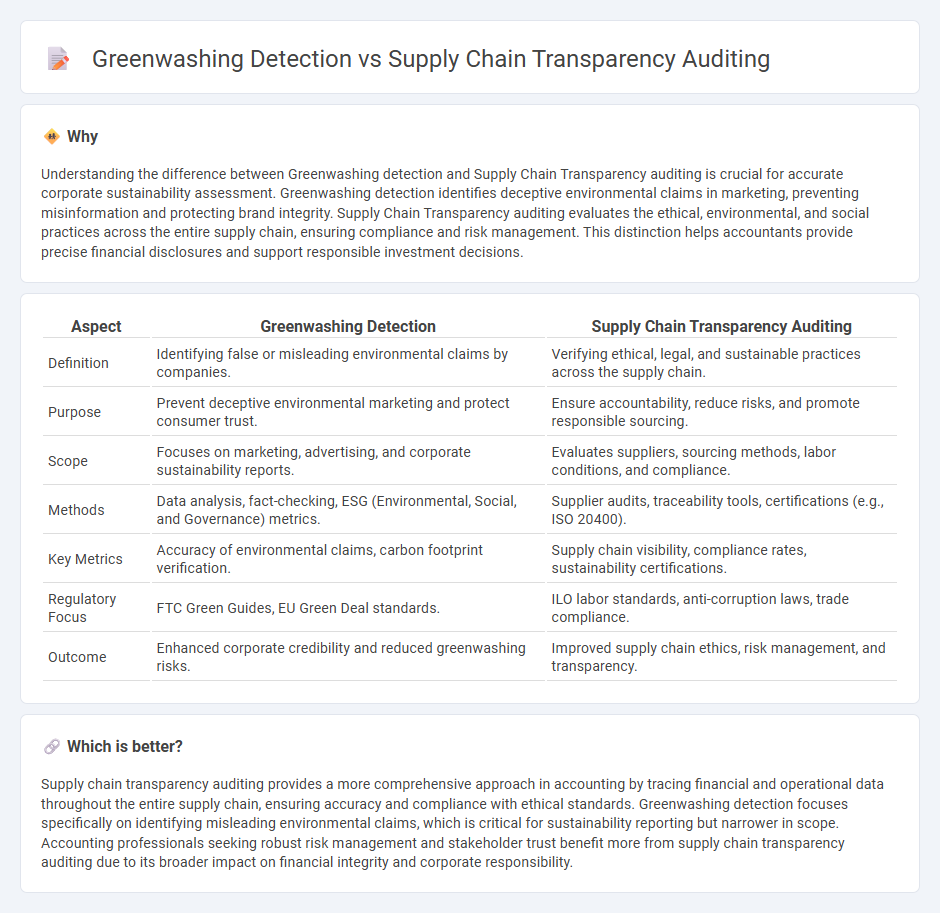
Greenwashing detection identifies misleading environmental claims made by companies, focusing on marketing and public communications to ensure true sustainability efforts. Supply chain transparency auditing examines the entire supply chain process for ethical, social, and environmental compliance, emphasizing traceability and accountability from raw materials to finished products. Explore how integrating both approaches enhances corporate responsibility and drives genuine sustainability.
Why it is important
Understanding the difference between Greenwashing detection and Supply Chain Transparency auditing is crucial for accurate corporate sustainability assessment. Greenwashing detection identifies deceptive environmental claims in marketing, preventing misinformation and protecting brand integrity. Supply Chain Transparency auditing evaluates the ethical, environmental, and social practices across the entire supply chain, ensuring compliance and risk management. This distinction helps accountants provide precise financial disclosures and support responsible investment decisions.
Comparison Table
| Aspect | Greenwashing Detection | Supply Chain Transparency Auditing |
|---|---|---|
| Definition | Identifying false or misleading environmental claims by companies. | Verifying ethical, legal, and sustainable practices across the supply chain. |
| Purpose | Prevent deceptive environmental marketing and protect consumer trust. | Ensure accountability, reduce risks, and promote responsible sourcing. |
| Scope | Focuses on marketing, advertising, and corporate sustainability reports. | Evaluates suppliers, sourcing methods, labor conditions, and compliance. |
| Methods | Data analysis, fact-checking, ESG (Environmental, Social, and Governance) metrics. | Supplier audits, traceability tools, certifications (e.g., ISO 20400). |
| Key Metrics | Accuracy of environmental claims, carbon footprint verification. | Supply chain visibility, compliance rates, sustainability certifications. |
| Regulatory Focus | FTC Green Guides, EU Green Deal standards. | ILO labor standards, anti-corruption laws, trade compliance. |
| Outcome | Enhanced corporate credibility and reduced greenwashing risks. | Improved supply chain ethics, risk management, and transparency. |
Which is better?
Supply chain transparency auditing provides a more comprehensive approach in accounting by tracing financial and operational data throughout the entire supply chain, ensuring accuracy and compliance with ethical standards. Greenwashing detection focuses specifically on identifying misleading environmental claims, which is critical for sustainability reporting but narrower in scope. Accounting professionals seeking robust risk management and stakeholder trust benefit more from supply chain transparency auditing due to its broader impact on financial integrity and corporate responsibility.
Connection
Greenwashing detection and supply chain transparency auditing intersect through their focus on verifying environmental claims and ensuring accountability. Supply chain transparency auditing provides verified data on sourcing, production, and environmental practices, which is essential to identify misleading greenwashing statements in corporate accounting reports. Accurate auditing minimizes risks of false environmental disclosures, enhancing trust in sustainability accounting and reporting frameworks.
Key Terms
Traceability
Supply chain transparency auditing employs comprehensive data tracking and verification methods to ensure traceability from raw materials to finished products, minimizing risks of fraud and environmental misrepresentation. Greenwashing detection targets false or exaggerated sustainability claims by analyzing inconsistencies between reported practices and actual traceable data within the supply chain. Explore advanced traceability technologies and methodologies to deepen understanding of effective supply chain transparency and greenwashing prevention.
Environmental, Social, and Governance (ESG) reporting
Supply chain transparency auditing evaluates the accuracy and completeness of disclosures related to Environmental, Social, and Governance (ESG) criteria, ensuring companies' claims about sustainability and ethical practices are verifiable through traceable data. Greenwashing detection identifies deceptive ESG reporting where businesses exaggerate or falsify their environmental and social impact to appear more responsible than they truly are. Explore advanced methodologies and technologies that enhance credibility in ESG reporting and minimize risks of greenwashing.
Third-party verification
Third-party verification plays a critical role in supply chain transparency auditing by independently assessing and validating claims related to sourcing, production processes, and compliance with ethical standards. In greenwashing detection, external auditors analyze marketing materials, corporate disclosures, and environmental impact reports to identify discrepancies between proclaimed sustainability efforts and actual practices. Explore how third-party verification strengthens credibility and combats deceptive environmental claims.
Source and External Links
How Can Supply Chain Audits Improve Business Transparency? - This page discusses how supply chain audits enhance business transparency by identifying inefficiencies and vulnerabilities, ensuring compliance, and building trust among stakeholders.
Bring Transparency to Your Business with a Supply Chain Audit - This article offers insights into conducting comprehensive supply chain audits to increase visibility, improve compliance, and enhance operational consistency.
Supply Chain Assessments and Process Audits | UL Solutions - UL Solutions provides independent audits and assessments to improve quality, prevent disruptions, and increase transparency in supply chains through risk-based supplier evaluations.
 dowidth.com
dowidth.com